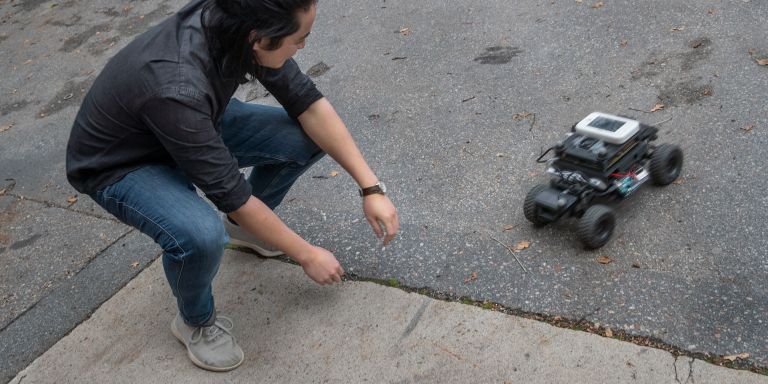
Karl Henrik Johansson
Professor of Network Control
Wallenberg Scholar
Institution:
KTH Royal Institute of Technology
Research field:
Control of dynamic networks


Wallenberg Scholar
Institution:
KTH Royal Institute of Technology
Research field:
Control of dynamic networks
Karl Henrik Johansson opens the huge garage door to KTH Integrated Transport Research Lab (ITRL). Draped in a blue sheet is a driving game, with a steering wheel, pedals and a broad screen. But this is far from your average racing game. All you have to do as a player is to overtake the car in front of you.
“We’re studying how your decision to overtake is influenced by your own speed, the oncoming car you see in the distance, and how willing you are to take risks. And what happens when the experiment is repeated, and you get better at overtaking? Do you become more inclined to take risks over time?” says Johansson, Professor of Network Control at KTH Royal Institute of Technology.
The results from the experiment can be used to teach self-driving cars how we humans behave in traffic. The autonomous vehicles of tomorrow must be able to understand drivers in other vehicles, who do not necessarily make rational decisions.
Daniel Kahneman and Amos Tversky developed what they called “Prospect Theory” to show that people don’t always make the best decisions. Kahneman was awarded the Sveriges Riksbank Prize in Economic Sciences in Memory of Alfred Nobel for this work in 2002.
Johansson’s research team is now attempting to understand whether similar behaviors occur in dynamic environments, and to apply that knowledge to next generation self-driving vehicles, and other autonomous systems.
“We record how people make decisions under time pressure and in a dynamic environment. We then use control theory and mathematical psychology, among other things, to create models capable of explaining our behavior on the basis of the experimental data we are gathering.”
Johansson has long conducted research on interconnected systems, and control of dynamic networks. The researchers have found ways of enabling different connected devices, from trucks to drones, to communicate with, and adapt to, each other. Truck manufacturer Scania has used the results to enable trucks to travel in close convoys, which reduces fuel consumption, and simplifies the driving experience.
But Johansson’s thoughts have recently turned to the role of humans in technology.
“How should humans and machines interact in the future? That’s the most important question. How can we build technology that is most beneficial to humankind?”
He considers that people have so far been obliged to make way for new technical solutions. Now the goal is to design systems capable of adapting to human behavior, and making decisions perceived to be natural by humans.
“We have to see this in a broader perspective than just self-driving cars. Imagine a future in which the network itself can make decisions based on information from different sensors. What decisions do we want to automate, and what decisions should we automate?”
“The Wallenberg Scholar grant enables us to describe pretty far-out ideas. At the same time, we can also be flexible in our research, and branch off in directions that appear more promising, perhaps departing from the original plan.”
The future is filled with robots to help us in our daily lives, but also to make sure we use society’s resources more efficiently.
“We’re trying to reason on these issues using mathematical tools and experimental test beds. We’re building models of how systems should work, and developing methods to make sure they actually do work in the real world,” Johansson says.
By setting up scenarios that can be mathematically formulated, the research team can develop new algorithms making the car or the drone a tad smarter.) But is it possible to create a mathematical model for human decisions?
“If we knew everything we need to know about human decision making, we would be able to build a mathematical model. But we don’t, of course – far from it. Instead, we’re trying to understand behaviors by integrating knowledge in the form of models with sensor data and other real-time information.”
The laboratory experiments are taking them one step closer to their goal.
“We’re building dynamic models for individual decisions, which yield not only average traits but also statistical guarantees for safety and efficiency in selected situations.”
Several scientific fields must be combined to make progress. Johansson recently held a workshop to which a number of psychologists had been invited.
“It was a really stimulating discussion, in which we addressed similar questions, but approached them from different angles. It’s clear that we need a dialogue between different scientific fields, in which we test the boundaries of our respective disciplines.”
When he takes his thought processes a step further, he also sees how researchers of the future will combine human and artificial intelligence. How can we better interact with each other, and with AI?
“At present we often discuss intelligence from the viewpoint of processing data, but the question should be more about interaction. This is a hugely exciting area to ponder.
But without the renewed grant he has received as a Wallenberg Scholar, he would not have had the courage to venture into this field. He presses home the point:
“The Wallenberg Scholar grant enables us to describe pretty far-out ideas. At the same time, we can also be flexible in our research, and branch off in directions that appear more promising, perhaps departing from the original plan.”
He also sees how industry can benefit from basic research. Today’s automobile, telecoms and energy sectors are now being interconnected in new technical systems operating side by side with humans.
“Although we don’t see practical results of this that can be incorporated in the control system of a truck, for example, this field will eventually change the world, as well as KTH and Sweden, if we’re successful.”
Text Magnus Trogen Pahlén
Translation Maxwell Arding
Photo Magnus Bergström